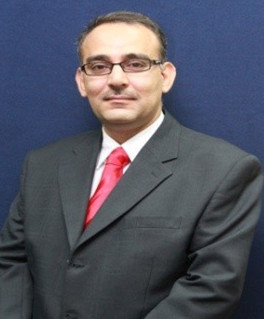Abstract—The organic solar cells have narrower absorption
spectrum than inorganic ones, making the task of widening
such narrow absorption spectrum of the organic solar cell
extremely important for increasing the efficiency of organic
solar cells. There has been studies on creating a tandem
structure with donor materials with complementary absorption
spectrums to maximize the absorption spectrum, but this
method results in a complex manufacturing process, because
tandem solar cells (whether serialized or parallelized) required
intermediate layers. One of the proposed solutions is
manufacturing solar cells with heterojunction structure, called
a ternary solar cell. In this study, a simple heterojunction
ternary solar cell was made using P3HT and PTB7 (two
polymer materials with stepped energy levels) as donor
materials, and PC61BM (a fullerene conductor) as a common
acceptor. P3HT and PTB7 each have an absorption peak of
550nm and 650nm, capable of absorbing both relatively short
and long wavelengths of light. Therefore, this structure
increased the absorption spectrum and the photo current
compared to when only one material was used. The
P3HT:PC61BM solar cell had JSC of 8.473mA/cm2, PCE of
2.97%, and the PTB7:PC61BM solar cell had JSC of
10.96mA/cm2, PCE of 3.77%, but the P3HT:PTB7:PC61BM
ternary structure had JSC of 11.949mA/cm2, PCE of
4.02%. Also, the current-voltage characteristics of the
P3HT:PTB7:PC61BM ternary solar cell was measured under
annealing temperatures from 80°C to 140°C to find the optimal
annealing temperature for the ternary solar cell. The optimal
annealing temperature was found to be 90°C, which is closer to
the 80°C of PTB7 (which is weaker to heat), which confirmed
that if two materials with different heat stability were used in a
ternary structure, the one with the lower annealing
temperature restricted the total efficiency.
Index Terms—Absorption spectrum, fullerene derivatives,
Heterojunction structure (ternary solar cell), organic solar cell,
polymer materials with stepped energy levels, optimal
annealing temperature.
Young Chan Kim is with the Stanford Online High School (e-mail:
youngchankim27@gmail.com).
[PDF]
Cite:Young Chan Kim, "Making Heterojunction Solar Cell Structure with Two Doner Polymer Materials and the Effect of Annealing Temperature," Journal of Clean Energy Technologies vol. 5, no. 5, pp. 371-377, 2017.


